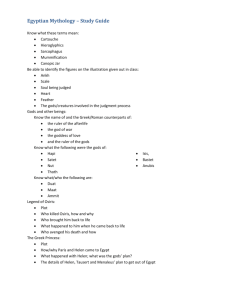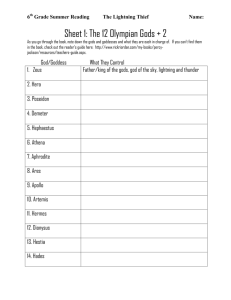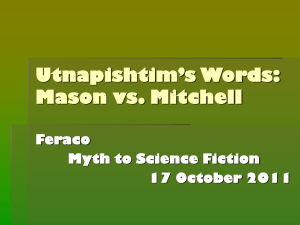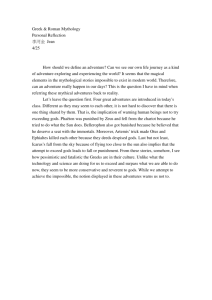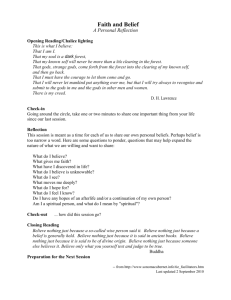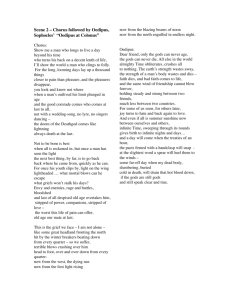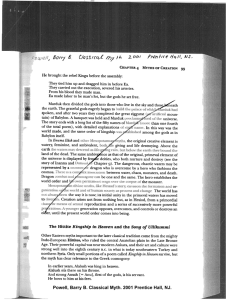The itako of North-Eastern Japan and Their Chants
advertisement
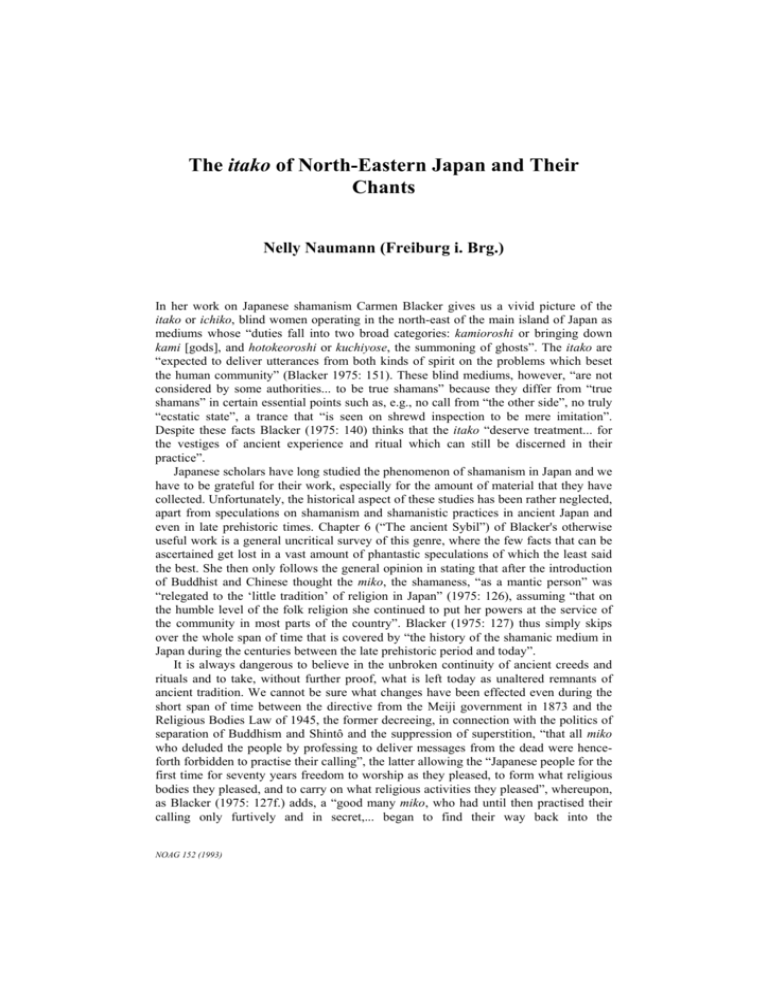
The itako of North-Eastern Japan and Their Chants Nelly Naumann (Freiburg i. Brg.) In her work on Japanese shamanism Carmen Blacker gives us a vivid picture of the itako or ichiko, blind women operating in the north-east of the main island of Japan as mediums whose “duties fall into two broad categories: kamioroshi or bringing down kami [gods], and hotokeoroshi or kuchiyose, the summoning of ghosts”. The itako are “expected to deliver utterances from both kinds of spirit on the problems which beset the human community” (Blacker 1975: 151). These blind mediums, however, “are not considered by some authorities... to be true shamans” because they differ from “true shamans” in certain essential points such as, e.g., no call from “the other side”, no truly “ecstatic state”, a trance that “is seen on shrewd inspection to be mere imitation”. Despite these facts Blacker (1975: 140) thinks that the itako “deserve treatment... for the vestiges of ancient experience and ritual which can still be discerned in their practice”. Japanese scholars have long studied the phenomenon of shamanism in Japan and we have to be grateful for their work, especially for the amount of material that they have collected. Unfortunately, the historical aspect of these studies has been rather neglected, apart from speculations on shamanism and shamanistic practices in ancient Japan and even in late prehistoric times. Chapter 6 (“The ancient Sybil”) of Blacker's otherwise useful work is a general uncritical survey of this genre, where the few facts that can be ascertained get lost in a vast amount of phantastic speculations of which the least said the best. She then only follows the general opinion in stating that after the introduction of Buddhist and Chinese thought the miko, the shamaness, “as a mantic person” was “relegated to the ‘little tradition’ of religion in Japan” (1975: 126), assuming “that on the humble level of the folk religion she continued to put her powers at the service of the community in most parts of the country”. Blacker (1975: 127) thus simply skips over the whole span of time that is covered by “the history of the shamanic medium in Japan during the centuries between the late prehistoric period and today”. It is always dangerous to believe in the unbroken continuity of ancient creeds and rituals and to take, without further proof, what is left today as unaltered remnants of ancient tradition. We cannot be sure what changes have been effected even during the short span of time between the directive from the Meiji government in 1873 and the Religious Bodies Law of 1945, the former decreeing, in connection with the politics of separation of Buddhism and Shintô and the suppression of superstition, “that all miko who deluded the people by professing to deliver messages from the dead were henceforth forbidden to practise their calling”, the latter allowing the “Japanese people for the first time for seventy years freedom to worship as they pleased, to form what religious bodies they pleased, and to carry on what religious activities they pleased”, whereupon, as Blacker (1975: 127f.) adds, a “good many miko, who had until then practised their calling only furtively and in secret,... began to find their way back into the NOAG 152 (1993) 2 Nelly Naumann acknowledged life of the folk religion. The fact that they had survived at all, despite the legal prohibitions, bears witness to the strength of their position in rural Japan”. But may we safely assume that more than 70 years of hidden existence have brought no alteration, despite the enormous cultural changes wrought during this time? And what means do we possess to discern “the vestiges of ancient experience and ritual” that Blacker assumes still to be present in the practice of the itako after the elapse of more than a millenium and a half? She herself (1975: 162) speaks of the “decline of the truly shamanic medium in the north [which] came about when the profession became the monopoly of the blind”; and in her opinion Hori “is right when he declares that the blind itako as they survive today are not shamanic persons”. On the other hand Blacker asserts that their practices, though “without inspiration or supernatural gift”, still “go back to antiquity”. But what do we know of this antiquity apart from the lively description of the shamanistic dance of the goddess Ame.no Uzume as part of a mythic scene where it is mixed up with other motives and purposes, 1 or of the equally lively description of a séance with the legendary Empress Jingû as medium – certainly no description of an early historic event (as Blacker seems to believe) but of a séance as it could be witnessed at the beginning of the 8th century 2 when the Kojiki and Nihongi, the oldest extant historical texts that contain these descriptions, were written, or of some simple statements of revelations of gods and their wishes through the mouth of men and women? 3 The few materials that indeed may relate the present itako of the north with the shamaness of ancient Japan have been neglected. That it might be possible to go back in the history of the itako of northern Japan to at least the 8th century, if only in a very general fashion, has partly been shown in a previous paper. 4 The term ita as the designation for a female shaman occurs in poem 1773 of the Man'yôshû, the oldest collection of Japanese poems compiled during the second half of the 8th century. It is further documented in poems of the 11th and 12th centuries, and in stories recorded in the 13th and 14th centuries where the word then appears as an essential part of the personal name of some miko “famous in the mountains of Kumano”. The stories show unambiguously that these miko were female shamans of the “possession type”: the gods take possession of the miko who in a state of trance then utters the words of the gods. The above-mentioned stories and some of the poems allude to the Kumano Pilgrimage. This focused upon the famous shrines situated in the Kumano mountains, one of the centers of Buddhist-Shintoist syncretism, and as such it was especially connected with the mountain-ascetics called yamabushi. 5 This pilgrimage, known since the end of the 9th century, became fashionable for emperors and abdicated emperors from the end of the 10th century on, and during the following centuries imperial visits to the Kumano shrines with great retinues occurred nearly every year. Later the military class took up the fashion, and the pilgrimage to Kumano became even more famous. 1 2 3 4 5 A short analysis of this scene is to be found in Naumann [1994], in print. For the questions in connection with this description see Naumann 1989, esp. pp. 310–311. Especially through the mouth of the FaFuri (see Miller and Naumann 1991: 48f.), but see also Naumann 1989: 311 with n. 11. For a detailed account of the following see Miller and Naumann [1994], in print. For a short description of the Kumano shrines, the syncretistic beliefs and the yamabushi connected with them see Naumann 1988: 232–235. A detailed account is found in Blacker 1975: 211ff. NOAG 152 (1993) The itako of North-Eastern Japan and Their Chants 3 Throughout the Middle Ages the Kumano yamabushi, travelling far and wide through Japan, propagating their syncretistic creed, and collecting money for the support of the shrines made it popular all over Japan; they also formed special relationships with local landowners who served as their patrons. It is during this time that the socalled Kumano-bikuni made their appearance, women in the guise of nuns, often married to or otherwise related with the yamabushi. They too helped to propagate the Kumano cult by selling amulets containing the seal of the most prominent Kumano god and explaining pictures illustrating the Buddhist hell and paradise. They also acted as mediums for the utterances of the gods and the spirits of the dead, thus partly continuing the activities of the former miko; but at the same time they also served as prostitutes for the pilgrims or for the travelers along the great roads as did other vagrant women all over Japan. This is the state of affairs to be met with at the beginning of the Edo period, the state Engelbert Kaempfer witnessed when he travelled twice from Nagasaki to Edo in 1691 and 1692, and of which he gives a detailed description (5. Buch, 5. Kapitel, p.183–185). 6 Sakurai Tokutarô 7 has pointed out that many traces are left that show the former activities of the Kumano yamabushi in the north-east of Honshû. He speaks especially of the great number of tutelary shrines dedicated to the Kumano gods whose priests are mostly the descendants of Kumano yamabushi who finally settled down in the region. We may presume that they had been accompanied by a similar number of Kumano bikuni as their wifes who had to act as mediums. They could be the link connecting the itako of the north-east, known to us for only a relatively short period, with the mediums of ancient Japan called ita. So it seems no mere accident when Blacker (1975: 30) too sees the survivals of the mantic gift of the ancient miko “in the travelling bands of women such as the Kumano bikuni, who like strolling minstrels walked the countryside offering their gifts of prophesy [sic] and divination, and in the blind women in the north who, without music and dance so essentially a part of the older miko's performance, transmit the utterances of numina and dead spirits”. The strong Buddhist coloring shown in the activities of the Kumano bikuni corresponds with the general trend of religious developments in Japan from the 12th century on. 6 7 “Unter diesen Geschornen befindet sich ein merkwürdiger Orden junger Dirnen, welchen man den Namen Bickuni oder Nonnen giebt, weil sie unter der Herrschaft und dem Schutze der Nonnenklöster zu Kamackura und Miaco stehen, dahin sie oder auch an die Isie nächst Khumano Tempel einen aljährlichen Tribut von ihrem Erwerb richten müssen, in deren oder angelegenen Gegend sie sich auch am meisten aufhalten, und um deshalb zum Unterschiede geistlicher Nonnen, Khumano no bickuni, genant werden. ... Die bettelnden Jammabosen widmen ihre Töchter dieser Profession, nehmen auch wol die Bickuni zu ihren Weibern. Manche unter ihnen sind in den Bordels erzogen... Ihrer zwo oder drei gesellen sich zueinander, gehen täglich eine oder mehr Meilen von ihrer Wohnung ab, und warten die vornehmen Leute ab, die ... vorbei reisen: jede macht sich zu einem besonders und singt ein Baurenliedchen auf... Nichts geistliches und armes ist an ihnen zu sehen, denn sie haben ihr geschornes Haupt mit einer schwarz seidenen Kappe verhült, sich mit bürgerlichen Kleidern net und sauber ausgeschmükt... ” (p. 183f.); speaking of the children of the yamabushi who come in great swarms and incommodate the travellers he says: “An verschiedenen Orten kommen sie den Reisenden, mit einer Schar Bickuni vermengt, wie ein Bienenschwarm entgegen, da man denn vor dem Lärmen, den sie mit singen, blasen, peroriren und anschreien machen, kaum hören kan. Es bedienen sich dieser Bergpfaffen die Leute zum beschwören, wahrsagen, deuten zukünftiger Dinge und zu anderm Aberglauben und Zaubereien, zum Dienst und Wartung der Tempel aber werden sie niemals gebraucht” (p. 185). Cf. Kokushi daijiten 4: 877d–878b s.v. Kumano bikuni. NOAG 152 (1993) 4 Nelly Naumann It is only natural that the rather simple beliefs connected with the indigenous gods of Japan came to be dominated by Buddhist conceptions, and were thus made to serve the ends of Buddhism. Just how the activities of the miko – their drumming and the tinkling of their bells when giving their oracles, their music and dance, their painting of votive pictures etc. – simply served as an aid toward future salvation, and for the attainment of Buddhahood, is shown very clearly in the Yôtenki, a tract written in 1223 in connection with another center of syncretism, the Hie shrines (ZGR 2/2: 624f.). The hotoke'oroshi 8 , the summoning of ghosts, is another feature developed mainly under the influence of Buddhism. Going back to the stories mentioned above, we notice that the large number of miko serving at the Kumano shrines during the 12th century were not able to help when the emperor wanted to learn what a sign meant that he had received while worshipping. It was only the miko “famous in the mountains of Kumano” bearing the word ita in their personal name who a t o n c e got possessed by the deity. No other means to call down the deity were needed, while in the mythic scene mentioned above it is the dance of the medium, in the legendary séance the plunking of the strings of a koto ‘cither’, that induce the deity to come and take possession of the medium. In other words, dancing, drumming and the tinkling of bells seem to have been the ordinary modus operandi for the miko attached to shrines, as the Yôtenki suggests. 9 Likewise, the itako today twangs the string of her catalpa bow or handles the beads of an immense rosary. But she also invokes the gods to descend by reciting prayers of a formal kind which she learns during her apprenticeship. To know all these texts by heart is indeed one of the requirements for her initiation and formal installation as itako. We are told nothing of such a practice in former times. Sakurai gives us samples of such texts from Shimokita-hantô, the northern-most part of Aomori prefecture, recorded on tape in 1968 (Sakurai 1974: 124–5), and from the north of Iwate prefecture collected and earlier published by Ishikawa Jun'ichirô (1970: 24–36; Sakurai 1974: 296ff.), with, as an appendix, parallel versions from the same region collected but only partly published by Koikawa Junjirô in 1953–54 (Sakurai 1974: 324–74). These texts serve several different purposes. Some are for calling down or sending off deities or ghosts, some for averting evil, some are magic spells. But these are all connected insofar as the prophesies given by the itako may afford measures to counteract the announced trouble or disaster. But there is also a text recited at the gates of farm houses when around the New Year the itako visit the villages where they usually make their rounds. As Sakurai (1974: 325) remarks, alterations and interminglings caused by the oral transmission of these texts make it difficult not only to restore their original form but even to write them down using Chinese graphs. Thus we find them mostly written only in kana script, and this together with the dialect of the region makes at least part of them hardly intelligible. Nevertheless, there remains enough to give more than a general impression. 8 9 hotoke originally means ‘Buddha’, but then the term was used to designate a deceased person suggesting that this person had attained Buddhahood, and thus finally hotoke came to mean also ‘a ghost’. It may be such a scene that is depicted in the Nenjûgyôji emaki picture scrolls of 1175 (scroll 5) showing a festival in the Imamiya shrine with a miko dancing with bells in her hands in the middle of the courtyard before the main hall of the shrine and several miko sitting to the right and left accompanying her with drums. NOAG 152 (1993) The itako of North-Eastern Japan and Their Chants 5 It seems that the first text the itako apprentice must learn consists of the congratulatory words used when making the rounds on New Year's or at the beginning of spring according to the old calendar. Thus this text is also called shôgatsu-ebesu or haruebesu, ‘New Year Ebisu’ or ‘Spring-Ebisu’. Ebisu, originally a god of the fishermen (cf. Naumann 1974), had during the Edo period become one of the Seven Gods of Happiness, but very often he is associated only with Daikoku, both of them being thought of as gods not only of happiness but also of wealth and abundance. Kadokake ebesu ‘Ebisu calling at the gate’ somo somo ya medetaya yara omoshiroya kono tono.no haru.wa hana saki aki.wa mi naru jôbu (= jôdo).no o-niwa.ni tama.wo toru kujaku sen-ni wa chôjaku (= kujaku).ni suhô (= shihô).no yama.wa takakereba ichiji.ni tonaete itadamori janjara ishi.woba iwa.to nari koke.no fusu (= musu) ma.ni koke.no tazuna ima.ni kimi.no mi-uchi.to iwaware.tamo Now then, how auspicious, how wonderful! When there is spring in this house the flowers blossom, and in autumn, the fruits ripen. In the garden of paradise they take the pearls, the peacocks, thousand and two birds, from the peacocks, because the mountains in the four directions are high, we at once get recited/called out janjara while the stones become rocks, and the moss grows on them, (with) the reins of moss now your house he deigns to bless. (Sakurai 1974: 296/Ishikawa 1970: 24f.) This text shows the same features as those recited or sung by the many other visitors who formerly came to the gates of the houses during the New Year month congratulating and receiving gifts, rice or money, in exchange. All that is said must be auspicious, and while the garden of paradise and the peacocks 10 belong to Buddhist conceptions, verses 16 and 17 are a slight variation of some part of the national anthem going back to a poem in the Kokinshû (10th century). Neither this text nor the custom connected with it has anything to do with shamanism. But it shows the low social status of the itako during the Edo period. It seems that the different callers and congratulants going their rounds during the First Month of the New Year or at the beginning of spring with their special congratulatory chants all belonged to the lowest social stratum, the hinin, which ranked outside the four classes into which the Edo society was grouped. They were people whose profession was either “unclean” or belonged to the performing arts, often with a religious tinge as with the itako. 11 10 The “Peacock king” is “a former incarnation of Śa-kyamuni, when as a peacock he sucked from a rock water of miraculous healing power” (Soothill 1970: 148b). 11 For another example of “cultic visitors” as the Japanese Folklorists use to call them, the harugoma ‘spring-horse’ and its congratulatory songs, see Naumann 1959: 215–226. NOAG 152 (1993) 6 Nelly Naumann Before any ceremony can begin, either the calling down of gods or the summoning of ghosts, a kami'oroshi ‘bringing down of the gods’ has to be performed. The recitation starts after an altar is prepared and offerings are set up. Thus the kami'oroshi is the next important text every itako has to learn. This kami'oroshi is a very long piece inviting gods, spirits, Buddhas and Bodhisattvas and their avatars. Some are called by their names, some illustrious, others obscure, still others are called only by generic terms or by circumlocution. Sometimes the order of succession seems quite natural, but sometimes it is impossible to find a clue as to the ordering, and much remains unintelligible. Still, all passages with their enumerations end with the same shôji mairase môsu ‘I (humbly) invite... to come’. For all these reasons here only the beginning of this text will be given: Kami'oroshi ‘Bringing the gods down’ Ichi.no yumi mazu uchinarasu yumi.no hatsune.yo.ba kono mura.no kamigami shôji mairase môsu nin.no yumi.no negoe.yo.ba tokoro.no kamigami shôji mairase môsu san.no yumi.no hibiki.yo.ba Nihon.wa rokujûrokka kuni.no kanzu.no suisaku.made shôji mairase môsu gojô.no kamikaze.no shichijô.no tatami shiki gojô.no mushiro shiki First [sound of the] bow With the initial tone of the bow which resounds by beating I invite the gods of this village to come. sono niwa yuzuru kake naka-yuhazu.wa Mida Yakushi nori-tanmo sue-yuhazu.wa gurikara Fudô nori-tanmo ... Nihon.wa rokujûrokka kuni.no kanzu.no suisaku.made shôji mairase... With the tone of the second bow I invite the gods of this locality to come. With the reverberating of the third bow the manifestations up to the number of the 66 provinces of Japan I invite to come. Spreading seven mats of the divine winds of the five virtues (?), spreading the straw-mats of the five virtues(?) in this courtyard plunking the bow-string on the middle bow-end Mida Yakushi condescends to ride, on the far bow-end the black dragon Fudô condescends to ride, ... the manifestations up to the number of the 66 provinces of Japan I invite to come... (Ishikawa 1970: 25ff.; Sakurai 1974: 297ff.) Among the gods further invited are the gods of the 16 big countries, the 500 middle countries, the 3000 small countries, the Buddhas of the infinite paradises, all the Bodhisattvas, the gongen ‘temporary manifestations’ of various places, the myôjin ‘bright gods’ of all shrines, the Kannon of Hase, the goddess of Ise, etc., etc. It seems that there is no single god or Buddha who is left out. It must be supposed that originally at the end of the ceremony a kami'okuri ‘sending away of the gods’ corresponding with the kami'oroshi had to be recited. But now this NOAG 152 (1993) The itako of North-Eastern Japan and Their Chants 7 has either been lost or has been conflated with the hotoke'okuri ‘sending away of a ghost’. The text recorded by Ishikawa (1970: 31f.; Sakurai 1974: 302) is rather short and remains partly unintelligible to me. Thus I shall give the translation of the version recorded by Koikawa which is not only clearer but also more outspoken: “No gods may remain under the floor, no gods may remain under the ridgebeam, no gods may remain under the mats, no gods may remain under the seams, no gods may remain in the eastern corner, no gods may remain in the southern corner, no gods may remain in the western corner, no gods may remain in the northern corner, no gods may remain in the corners of the four directions, they may not stand at the door, they may not stand at the windows, the 68.006 Buddhas 12 – without the danger of rain, without the hindrance of wind – I send away, the still remaining gods – without any danger, the still remaining Buddhas – without any hindrance I send away, the gods having a master I send to the shrines and woods, the gods without a master I send to the wilderness, the mountains, hills, islands, the Buddhas having a master I send to the cloisters, the Buddhas without a master I send to the wilderness, the mountains, hills, islands.” And this “is repeated four times” (Sakurai 1974: 344). The ‘bringing the gods down’ as well as their sending off shows no special feature above the simple fact of a very general plea to all divine beings to be present for the ceremony, whether it is connected with gods or with ghosts, and to leave when it is finished. A similar formal calling and sending off of deities seems to be encountered for the first time in the (Kenkyû san-nen) Kôtai jingû nenjûgyôji of 1192, a text describing the ceremonies conducted in the course of the year at the Inner Shrine of Ise. Here the calling down and sending off are connected with an equally formalized ceremony of divination. The ceremony as such is already described in the (Kôtai jingû) Gishikichô of 804 as a short formalized asking for the Divine Words of the sun goddess by plunking the strings of a koto. During the following centuries this ceremony has been greatly elaborated while the divination itself has been reduced to a whistle into the koto by the appropriate shrine official. The resounding or not resounding of the koto is taken as a sign whether the offerings are clean or not. The official first addresses the sun goddess announcing the wish to know by divination whether the offerings are clean, then he plunks the strings of the koto three times, and then he sings or recites the following: ahari.ya yuhasu.to mausanu asakura.ni ama.tsu kami kuni.tsu kami orimashi-mase ahari.ya yuhasu.to mausanu asakura.ni naru ikatsuchi.mo orimashimase ahari.ya yuhasu.to mausanu asakura.ni kami.tsu oho'e shimo.tsu oho'e.mo mairi tamae Ah! In Asakura, not called a bow-end, may the heavenly gods, the earthly gods descend! Ah! In Asakura, not called a bow-end, may the thundering gods also descend! Ah! In Asakura, not called a bow-end, may the great rivers above, the great rivers below also come! (ZGR 1/1: 398b) There follows the whistling and a dispute concerning the result, then the official again plunks the strings of the koto and finally the gods are sent off by using the same 12 I am in doubt whether in this context hotoke means ‘Buddha’ or ‘ghost’ or has simply to be taken as both (Cf. note 8). NOAG 152 (1993) 8 Nelly Naumann song but now asking them to ascend (ZGR 1/1: 399a; see also Miller and Naumann [1994], in print). Since “the heavenly gods and the earthly gods” are a l l the gods, the addition of the thundergod should not be necessary, while the role of the “great rivers above” resp. “below” remains unclear. The attribute “not called a bow-end” that is used with the place name Asakura also remains unclear. It seems that this stereotyped song has been added quite late and in the course of further formalization. But here the Kôtai jingû nenjûgyôji gives an interesting gloss: “Now, some years ago, at that time the mikannagi uchindo Hafuribe Sukeyoshi kept this song as his secret treasure and did not transmit it among his fellow officials. Once in the night of the divination this Sukeyoshi was late and during this same divination Miyoshi went [for him] east and west and thus the service came to an end. Therefore, for later times, on the following morning they called for this Sukeyoshi that in front of the Aramatsuri shrine they should get it transmitted. But because it seems Sukeyoshi was dead, though we are afraid that there may be errors we have nevertheless written it down for posterity and added this gloss.” (ZGR 1/1: 399b). This shows that this song had been orally transmitted if it was not invented by this Sukeyoshi himself, the mi-kannagi uchindo being the official in charge of this ‘divination’. Compared with the elaborate text the itako uses it is a very simple song, even though it is characterized by repetition and parallelism. As it seems rather far-fetched to suppose that the itako themselves have invented their long and complicated invitation list, a look into other traditions may prove illuminating. An invitation list of a kind very similar to that of the itako is indeed to be found among the secret scriptures of the so-called Yoshida Shintô, a list, moreover, drawn up by Yoshida Kanetomo (1435–1511), the founder of Yoshida Shintô, himself. Demura Katsuaki (1975: 153ff.) reproduces this list of gods who are invited to descend to “Japan's most sacred site” within the Yoshida shrine in Kyôto; it includes not only all the gods of heaven and earth that may exist but also Devas, ghosts, and bad demons, in short, “any being possessing some spiritual power”, as Demura (1975: 155) remarks. The idea of inviting all the gods to attend the ceremony of divination may go back to the official proceedings in Ise, but in all these cases the question arises w h y all the gods are thus called down, since during the ceremonies they are supposed to attend they have no function at all. Moreover, the gods who are asked to speak through the mouth of the itako are invited by a special prayer called utagura, literally ‘song-seat’, and these prayers differ according to the deity invoked; but the number of deities thus called seems rather small. Sakurai (1974: 303) speaks of two ways for kamikuchi, the ‘speaking of gods’ through the mouth of the itako: either the family as a whole is concerned and the god is asked to fortell the fortune for the coming year, how the crops will come out, and what may befall the family as a whole – or the fate of each single member of the houshold must be foretold. First the god especially worshiped as housegod is called and he is asked only once on behalf of the master of the house. Then the other gods worshiped are welcomed, and eventually the individual guardian deities are asked. Ishikawa (1970: 28f.) and Sakurai (1974: 303ff.) following him give the prayers for the most prominent folk deities of the region: Yama.no kami, the ‘mountain deity’, Hachiman, and Oshira-sama; Koikawa records a few more. For Yama.no kami Ishikawa has two versions; both differ only in insignificant details and in the sequence of a few lines (the same holds true for Koikawa's version). Thus I give only the first, slightly more coherent version: NOAG 152 (1993) The itako of North-Eastern Japan and Their Chants Yama.no kami.no utagura I 9 (Ninohe-gun, Fukuoka-chô, Nimata, Nakamura Iso, oral communication). Yama.no kami Mountain-deity, chichi.no mi-na.yo.ba dai-ô.to The name of your father is Dai-ô môsu haha.no mi-na.yo.ba taihiraThe name of your mother is Taihira gozen. gozen.to môsaruru se.wa takaku Your size is tall iro kuroku your color is black managu kidakaku your eyes are high-spirited hana takaku your nose is high kuchi hiroku your mouth is broad. nanuka nanayo.ga uji.ni mi.wo During seven days and seven nights hold mochitamai ya yama.no kami yourself up mountain-deity. nanuka nanayo.ga uji.ni o-san.no During seven days and seven nights leave himo tokase ya yama.no kami open the birth-cord, mountain-deity. obo-e nando.to tatematsuru As birth-food I offer san-koku san-shô san-gô 3 koku, 3 shô, three gô [of boiled rice]. agarase tamai ya yama.nokami Deign to eat, mountain-deity. obo-gi nando.to tatematsuru As birth-clothing I offer on-take.ni.wa kokono-jin for the length nine jin (fathoms) sode.wa nana-jin for the sleeves seven jin. on-kise tamai ya yama.no kami Dress yourself, mountain-deity. jûni-nin.no on-ko.wo soroide Matching your twelve children, yama.no kami mountain-deity, ne, ushi, tora, u, tatsu, mi, uma, Rat, ox, tiger, hare, dragon, snake, horse, hitsuji, saru, tori, inu, i.made goat, monkey, bird, dog, and hog, yama.no kami mountain-deity. higashi-yama.sa matagi-dono To the Eastern Mountain give Matagidono na.wo tsuke tamai ya yama.no as name, mountain-deity. kami nishi-yama o-matagi-do na.wo To the Western Mountain give Smalltsuke tamai ya yama.no kami Matagi-do as name, mountain-deity. toyama.ga sase.no sakakiba.no Unto the sakaki-leaves of Toyama.ga sase moto shôji mairase môsu I invite you to come. mairu mi-kado.wa nana mi-kado The gates where I go, seven gates, mi-kado mi-kado.wa jûgo.no tsuki gate for gate on the moon of the Fifteenth, mazu morotomo.ni yone uchimaite now, all together we scatter rice, mi-dô hirakô ya and may your hall thrive! (Ishikawa 1970: 28f.; Sakurai 1974: 303f.) This chant, directed to the mountain deity and ending with an auspicious wish for the owner of the house, follows the pattern of congratulatory songs for the beginning of the year: it alludes to or gives the particulars of the special qualities or the special circumstances in praise of the deity who is invited to bring good luck, wealth, prosperity. Though no beauty, as the description of her appearance shows, the mountain deity appears here as a female who gives birth to twelve children the names of whom correNOAG 152 (1993) 10 Nelly Naumann spond to the twelve animals of the zodiac, i.e. rat, ox, tiger, hare, etc. – she functions as the deity of the year with the twelve months as her children. This is a peculiarity of northern Japan where the number twelve (jûni) is often directly part of her name, so that she is called “Jûni-sama” or “Jûni yama.no kami”, and where the number twelve also plays an important role in everything else concerning her (cf. Naumann 1964: 50ff.). But Yama.no kami functions not only as a “Year god” (Naumann 1964: 72ff.), she is also a helper in childbirth (Naumann 1963: 218ff.) and a hunting deity (Naumann 1963: 150ff.). Her complex character also comes to the fore in the mention of the name “Matagi” to be given to the “Eastern” and “Western Mountain”. There are still villages in northern Japan inhabited by a hunting population calling themselves matagi, among whom the traditional worship of Yama.no kami is especially pronounced. The hunting rites connected with Yama.no kami show a strong affinity with those of the Siberian peoples, especially in his/her role as the Master of the Animals. This gives a complex background for the popularity of Yama.no kami in northern Japan. As far as Hachiman, a god prominent and well-known all over Japan is concerned, a few notes may suffice. He is shown as the god dexterous with bow and arrows and as the possessor of a sword which “cuts when drawn and cuts when not drawn”, and appears in Buddhist guise (cf. Ishikawa 1970: 29; Sakurai 1974: 304). The case is somewhat different in regard to Oshira-sama, one of the prominent gods especially worshiped by some itako, and a god otherwise connected with sericulture and with the horse. The prayer-songs directed to Oshira-sama are of two different kinds: songs describing all the operations connected with the manufacture of silk, from the rearing of the silkworms to the storing of the woven silk, and chants recounting his origin. Sakurai records a short utagura of the first type from the Ninohe district and one of the second type from Shimokita-hantô which is of interest in regard to the “story”, but it is too long to be given here in extenso. Thus I shall restrict myself more or less to summarizing the content: A short introduction tells of a rich man owning a horse called ‘chestnut Sendan’. The horse suddenly falls ill: “... though water be given he did not submit / though grass be given he did not submit / whatever given him to eat he did not eat...”. The horsedoctor is called and announces that the horse is love-sick for the daughter of the house. The rich man orders the horse to be abandoned in the mountains and “Jirô and Tarô” fulfill the task by flaying the horse alive and hanging the hide on a mulberry tree. “There a black cloud came down from heaven and with a terrible stormwind the hide was brought to India.” Now the girl fell ill and could not recover; prayers were offered day and night, and in the end a black cloud came down from heaven. The face of the chestnut Sendan was seen in it and he started to talk with the girl when he suddenly seized her and had her fly with him to India. In the following year, on the 16th day of the Third Month on a stone in the room of the girl there were found white and black insects nobody knew, but in the end an old man explained that the white ones were the girl, the black ones the chestnut Sendan, and that they had to be given mulberry sprouts “cut on a silver board, cut with a golden knife” (Sakurai 1974: 124–125). The Oshira-prayer recorded by Koikawa (Sakurai 1974: 370–74) gives more or less the same story but in a version much more elaborated and impregnated with Buddhist elements. It adds a description of the rearing of silkworms and the manufacturing of silk, but lacks the usual description of the Oshira-puppets used by some itako for divination. These are sticks originally made of the wood of the same mulberry tree on which the horse hide was hung, one of them, the girl, ending in a human head, the other one, the chestnut Sendan, in a horse's head. Such “Oshiragami” or “Oshira-sama” are in NOAG 152 (1993) The itako of North-Eastern Japan and Their Chants 11 some regions kept by the itako themselves; in other regions every family has its own pair of them, kept in a box on the house altar and taken down when the itako makes her visits at the appointed times. She holds the puppets in her hands and has them “dance” until she gets into her supposed trance and utters the words of the god. Every year the puppets get a new garment, a square piece of fabric either with a hole in the centre like a poncho or else simply put as a whole over the head and then fastened. The many slightly differing stories of the origin of this god go back to the Chinese legend of the origin of the silkworm and the silkworm goddess related in the Shen-nüchuan and Sou-shen-chi (4th century). 13 The relatively short utagura of the first type concentrating on the rearing of silkworms has some nearly parallel sections: the insects do not want to eat until they get mulberry leaves which must be cut with a golden knife, etc. A very long and much elaborated song about the rearing of silkworms is recorded as a congratulatory song of the harugoma, the ‘spring horse’ (translation in Naumann 1959: 222 n. 261). From the above we can see that the songs used by the itako to call special gods for giving oracles through her mouth do not much differ from those used on other occasions, such as on the congratulatory visits around New Year. The legends telling of the “origin” of a certain god are recorded elsewhere too, and the characteristics of the gods are to be found in the general folk belief of the region. Again, there is nothing especially “shamanistic” in these chants, rather they point to formal ceremonies where the gods are addressed with formal prayers. In the case of the gods called on behalf of the individual members of the household, Ishikawa points out that everyone has his or her own ichidai-sama, his ‘life-god’, according to the zodiac-animal of the year in which he is born, and all corresponding with certain Bodhisattvas (as, e.g., the Thousand-hands Kannon for the year of the rat etc.), or else a ketai-gami or ‘guardian-god’ is worshiped. I give here the text and translation of the utagura addressed to the ketai-gami in general: kesa.no asahi.wa ôgon.ni mattaru asahi kana nanae.no kumo.wo wakede terasô ya shisetsu.ni tsuki kawaru kawaran mono.wa matsu.no midori yone uchimaite itsumo yokare.to kami.e môsu This morning's morning-sun a morning-sun all (?) gold. Onto the sevenfold clouds may he especially shine. Within the four seasons the moon changes, what does not change is the green of the pine trees. Scattering rice that things may always be well I tell the gods (Ishikawa 1970: 30; Sakurai 1974: 306) This is simply a prayer, and the same may be said for a few texts given under the heading of harae, originally ‘exorcism, cleansing’, but also ‘prayer’. There is a supplication for house and family (kanaigitô), usually held around the beginning of spring to protect the family against any danger and invite peace and prosperity: kyô.wa dainan shichi-nan akunan Today, the great calamities, the Seven sainan kyônan Calamities – namely evil, catastro13 Translations and references can be found in Naumann 1959: 199–202 and 207ff. One version also in Blacker 1975: 150. NOAG 152 (1993) 12 Nelly Naumann kyôzetsu kuze sukuze.no sainan hi.no sainan minashi.no tsurugi.no sainan kitaru to yûte kano sainan kano jûzu.wo motte harai tamae kiyome tamae kami.wa sagari nobori sagari kudari yanai.no uchi.ni nigiri kumori naki yô.ni mi.no uchi.ni uki shizumi naki yô.ni tônen.no mi-kisen mi-kinen mi-kitô.to uyamatte môshi tatematsuru phes, misfortune, the evil of falsehood, of bad habits, of a former life, the calamity of fire, and the calamity of a fancy sword to come – all these calamities holding that rosary you shall sweep away, you shall cleanse. The gods go down and up, go down, come down, so that in this house there may be nothing cloudy, nothing turbid, that there may be no up and down for you this year's vow, prayer, supplication we say with reverence. (Kawaguchi Fuji, oral tradition; Ishikawa 1970: 35; Sakurai 1974: 308f.) There are two kinds of prayers for an individual (migitô), the tsukijoroe ‘completing the number of the months', and the nigenjoroe ‘completing the human being’. The former consists in listing the gods to be worshiped each month and asking their protection; but the list of the gods may differ. Thus the prayer Koikawa (Sakurai 1974: 347f.) records has “For the thirty days of the First Month, Haguro.no gongen may protect closely; for the thirty days of the Second Month, Kumano.no gongen may protect closely”, and so forth, while the prayer recorded by Ishikawa (1970: 33; Sakurai 1974: 309f.) starts with Yuse daimyôjin followed by Yadate daimyôjin etc. Koikawa (Sakurai 1974: 348–350) gives also a hijoroe ‘completing the number of the days’ which works exactly in the same way. The nigenjoroe, again a very long text, starts with an introduction in which Daruma, Amida and Yakushi are invoked and Fudô and Bishamon are named as those who deign to make the human being. Then all parts of the body are named together with the god or Buddha who made them. Just a sample: “... the head is made by Taisan-Buddha, the forehead is made by Hyakusan-gongen, the eyes are made by Nikkô, the eyelashes are made by Teiso-Bodhisattva, the nose is made by Manjusri, the face is made by Benzaiten, the mouth is made by the god Kanai, the teeth are made by Haguro-gongen...” The prayer thus again names Buddhas, Bodhisattvas and gods in a motley order and ends with the assertion “for your good fortune/blessing I minutely finished the reading” (Ishikawa 1970: 33f.; Sakurai 1974: 310–312). There is also a short prayer when the offerings are taken down, and there are several majinai ‘spells’, against bad dreams, against insects, and against the weeping of children during the night, some long, some very short like the last one: “The old fox in the Shinoda woods, when he cries during the day, then he does not cry in the night”. This has to be repeated three times (Ishikawa 1970: 36; Sakurai 1974: 313). Chants or prayers of this kind may be found among the Buddhist or syncretistic incantations or NOAG 152 (1993) The itako of North-Eastern Japan and Their Chants 13 spells used for kaji-kitô, the magical invocations originating in esoteric Buddhism (cf. the many examples in Ono 1958). I have left out the purely Buddhist prayers and Su-tras and those thoroughly tinted by Buddhism or going back to Buddhist beliefs, such as the jigokusagashi ‘searching hell’ or gokuraku ‘paradise’ which bear witness to the syncretistic soil from which these prayers evidently sprang. Indeed, as we hear nothing of the recitation or chanting of fixed prayer-songs by the miko while, from the end of the Kamakura period on, such activities are mentioned in connection with the Kumano bikuni and other vagrants with a kind of religious call wandering along the great roads and visiting the villages, we may well presume that it is only from this time on that these chants, also incorporating local beliefs, came into existence. This would fall together with the profession of the itako slowly becoming “the monopoly of the blind”. The drumming and dancing as practised by the miko of former times would already have been lost when the Kumano bikuni and other vagrant women became their successors as “mantic persons”. It is impossible, at least for the moment, to go much further. Even this superficial survey has shown the indebtedness to Buddhism as well as to the syncretistic beliefs prevailing until the Meiji restauration within all “Shintô”-shrines, but likewise to the ordinary folk tradition. Scanty as the Japanese material is, a thorough study like the one B.C.A. Walraven (1985) has devoted to the Korean muga, the chants of Korean shamanism, would perhaps lead to better founded conclusions. Literature Blacker, Carmen 1975 The Catalpa bow. A Study of Shamanistic Practices in Japan. London. Demura Katsuaki 1975 Yoshida shintô ni okeru on'yûkyô no hiden – toku ni jûhachi-shintô-gyôji no seiritsu ni tsuite. In: Shintô-shi kenkyû 23: 56–75, 142–173. Ishikawa Junichirô 1970 Kuchiyose fujô. Iwate-ken Ninohe chihô ni okeru itakosan no seitai to denshô. In: Nihon Minzokugaku 68: 1–48. (Kenkyû sannen) Kôtai jingû nenjûgyôji. In: ZGR 1/1: 354–476. Kôtai jingû gishikichô. In: GR 1: 1–44. Miller, Roy Andrew und Nelly Naumann 1991 Altjapanisch FaFuri. Zu Priestertum und Schamanismus im vorbuddhistischen Japan. Hamburg. (Mitteilungen der Gesellschaft für Natur- und Völkerkunde Ostasiens, Bd. 116.) [1994] Altaische schamanistische Termini im Japanischen. (Teil 1). In print. Naumann, Nelly 1959 Das Pferd in Sage und Brauchtum Japans. In: Folklore Studies, Vol. XVIII: 145–287. 1963 Yama no kami – die japanische Berggottheit (Teil I: Grundvorstellungen). In: Asian Folklore Studies, Vol. XXII: 133–366. 1964 Yama no kami – die japanische Berggottheit (Teil II: Zusätzliche Vorstellungen). In: Asian Folklore Studies, Vol. XXIII–2: 48–199. NOAG 152 (1993) 14 Nelly Naumann 1974 1988 1989 [1994] Whale and Fish Cult in Japan: a Basic Feature of Ebisu Worship. In: Asian Folklore Studies, Vol. XXXIII: 1–15. Die einheimische Religion Japans. Teil 1. Bis zum Ende der Heian-Zeit. Leiden. (Handbuch der Orientalistik V/4/1). Die Wo-Königin Pi-mi-hu und ihr “Weg der Dämonen”. In: Bruno Lewin zu Ehren. Festschrift aus Anlaß seines 65. Geburtages. Bd. II Japan. Geschichts- und kulturwissenschaftliche Beiträge. Bochumer Jahrbuch zur Ostasienforschung 1989: 309–326. Schamanistisches in den japanischen Mythen. In print. Ono Kiyohide 1958 Kaji kitô himitsu taizen. Tokyo. Sakurai Tokutarô 1974 Nihon no shamanizumu. 1. Minkan fujô no denshô to seitai. Tokyo. Soothill, William Edward and Lewis Hodous 1970 A Dictionary of Chinese Buddhist Terms. Repr. Taipei 1970 1London 1937). Walraven, B.C.A. 1985 Muga. The Songs of Korean Shamanism. Proefschrift. Leiden. NOAG 152 (1993)

